Sustained success is everything in professional sports.
Teams often have to find a healthy balance between winning in the present and keeping a steady supply of future assets. While it’s possible to do both, it’s difficult to achieve Stanley Cup contender status without trading away good prospects and draft picks and it’s even harder to retain all of those prospects when their contracts expire.
For this reason, teams often have to figure out which prospects have a future in their core in the future and which likely won’t make the cut, due to internal competition, internal evaluations and the like.
For this reason, evaluating talent is so important. It’s also why ranking talent isn’t something that shouldn’t be done in a typical list structure. Instead, it should be structured more like a tier-list.
Sticking with the trend from last season, the prospects for the Boston Bruins will be ranked in a prospect-pyramid system as opposed to a typical list.
Related: Bruins 2018-19 Prospect Pyramid
The pyramid last season featured many prospects, some of whom played with the Boston Bruins, some who spent time in other leagues and even some who were traded or won’t be part of the Bruins’ organization at all this season.
Excluded from this list were Jakob Forsbacka Karlsson and Peter Cehlarik who have both played in more than 25 NHL games each.
What is a Prospect Pyramid
Before we actually construct the Bruins’ prospect pyramid, it’s important to re-establish what all of the tiers in the pyramid mean.
Instead of using arbitrary evaluation tactics to decide which prospects are marginally better than the next in the list, the pyramid serves to lump prospects with similar grades on equal tiers.
Here’s a breakdown of how the tiers work:
Tier 1 – Elite talent (Jack Hughes, Rasmus Dahlin, Auston Matthews, Connor McDavid-level talent)
Tier 2 – Very, very good prospects with a real chance of being top-six forwards, top-two defenders or good starting goalies)
Tier 3 – Good players who fall just short of tier 2, perhaps due to lower ceilings, but who are distinctly better than tier’s below them
Tier 4 – Distinct shot at making an NHL roster and being a contributor (top-nine forward, bottom-four defender, fringe starter or backup goaltenders
Tier 5 – Players who likely don’t project to be anything more than a role player in the NHL as their ceiling – these players chances of making the NHL aren’t very high compared to their comrades (sometimes due to being relatively unknown at this point)
With that, let’s take a look at how the Bruins prospect pyramid looks for the 2019-20 season:
Tier 1 – Empty
The Bruins have a lot of very good prospects, but none rank in the same level as some of the top-tier prospects around the league. In fairness to the team, they haven’t drafted anywhere inside the top-10 since they selected Dougie Hamilton back in 2011 and nowhere in the top-five (or three) since Tyler Seguin in 2010.
Despite this, the Bruins have still found gems like Charlie McAvoy (14th overall) and David Pastrnak (25th overall) and even Jake DeBrusk (14th overall) and Brandon Carlo (37th overall) on top of the other plethora of NHL-level talent on their squad who were taken outside of the first round entirely.

For now, this tier will remain empty for the second-consecutive season.
Tier 2 – Bruins Prospect Pool is Still Strong
The second tier of the pyramid, in contrast to the first tier, is jam-packed with talented players who could all make contributions to the team as early as 2019.
The prospects in this tier include:
Jack Studnicka, Urho Vaakanainen, Trent Frederic and Jakub Lauko.
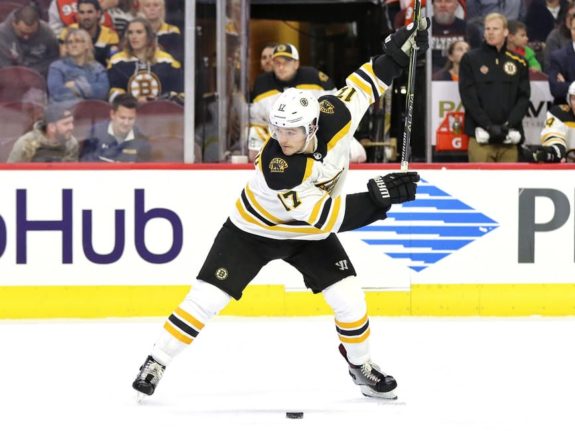
The top prospect in the Bruins system last year was Ryan Donato. After a red-hot start to his career in the 2017-18 season, he’d struggle to find his footing for the 2018-19 season in his true rookie year.
The Bruins would package Donato with a draft pick to acquire Charlie Coyle from the Minnesota Wild last season. While parting with Donato stung, Coyle has proven to be worth the investment thus far.
Now, the Bruins top prospect is a little harder to figure out as there really isn’t clear-cut No. 1 like there was last season with Donato. That’s fine considering the whole point of this pyramid is to try and get away from those sorts of rankings altogether.
Vaakanainen remains in this tier for the Bruins as a top-tier puck-moving prospect from the back-end who has the ability to eat minutes and play in all situations. While he may not be on the Bruins’ opening night roster, he’ll undoubtedly be in the discussion for one of their first call-ups if injuries should strike.
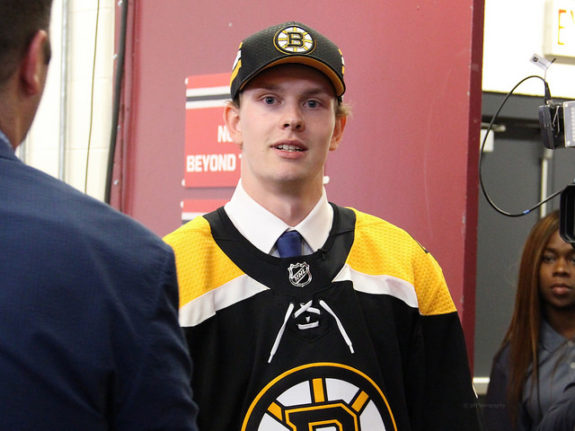
Both Studnicka and Frederic remain in this tier, though Studnicka is probably the Bruins’ best-bet as far as future top-six center options go internally.
The two players bring different styles of play to the table but are effective in what they do. Both should be in consideration for playing time with the big club in 2019-20 if they continue to display positives in Providence.
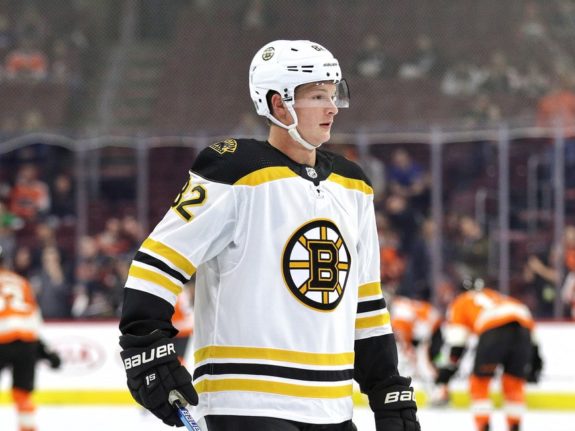
A riser from the 2018-19 pyramid who now finds himself in tier 2 is Lauko.
After being drafted in the third round of the 2018 NHL Entry Draft, there was significant interest in Lauko given his high-upside.
It was safer to put him in the third tier of prospects given how raw of a talent he was, but after a 21-goal and 41-point season in 44 games with the Rouyn-Noranda Huskies in his rookie season in the QMJHL, it became clear that Lauko’s potential was among the highest in the Bruins’ system
Fans who have seen Lauko know just how good he is and how good he can be. With the chance to turn some heads and build confidence in Providence this season, he’s definitely a player to watch.
Tier 3 – Some Nears Misses From Tier 2
The third tier of prospects for the Bruins will feature some familiar names for fans of the team. Whether it’s new prospects who are still to fresh to place higher (or lower) or older prospects who need to make their mark sooner than later, this tier is definitely worth watching.
The prospects in this tier include:
Zach Senyshyn, Jakub Zboril, Jeremy Lauzon, Kyle Keyser, Jeremy Swayman and John Beecher.
One of the most interesting names to keep an eye on for the 2019-20 season in this is Lauzon.
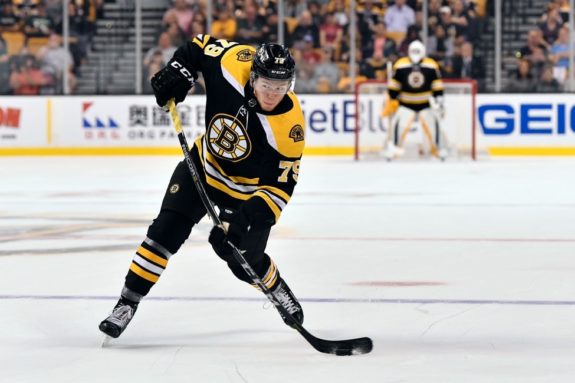
While the 6-foot-1, 205-pound left-shot defender may not have found his stride offensively in the AHL or in his 16 games of NHL experience, he’s still been a reliable two-way defenseman who looks good every shift.
Not one to shy away from physical play, to drop back into coverage or to join a rush depending on the situation, Lauzon has the smarts to be a very effective NHL blueliner one day.
It’s hard to imagine he’ll make an impact in the NHL as a top-two defender but a second-pairing player who skates in all situations is certainly a possibility for him one day. He may be the most NHL-ready defender amongst all Bruins prospects despite having a lower long-term upside than Vaakanainen.
He’s currently in the third tier of prospects but his upside is still that of a top-six forward.
It was said last year and it’ll be said again about Senyshyn – his rare combination of speed, skill and physicality make him an intriguing top-six option at the NHL level.
While he’s been labeled as a bust throughout his career, the 22-year-old right-shot winger has produced one goal and three points through his first four games in the NHL.
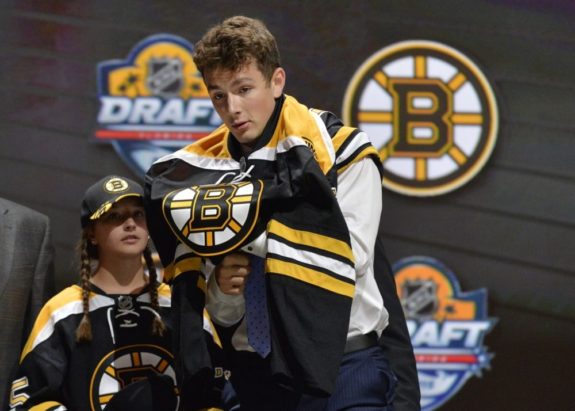
Not only did Senyshyn record a pair of assists in his 2019-20 season debut, he simply looked like he belonged throughout the game and was consistently doing what he needed to do to generate offense and create opportunities for his linemates.
He doesn’t need to maintain the point production if he can simply play as consistently effectively as he has thus far.
Another familiar name from the 2015 NHL Draft Class is Zboril. The 13th overall pick in the class, Zboril will forever be linked to players like former teammate Thomas Chabot, Mathew Barzal, Kyle Connor and the like.
It’s fair to be disappointed in Zboril’s development thus far but it’s also important to separate certain truths from each other.
Yes, Zboril has been very slow as far as developing into an NHL defender is concerned. Yes, Zboril will probably never be as good a player as Chabot is despite being taken five selections ahead of his former Saint John Sea Dogs teammate.
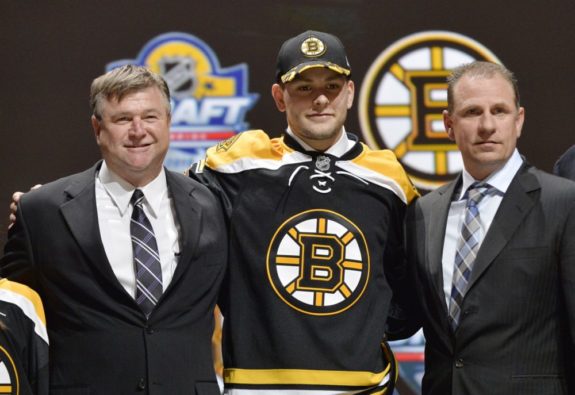
What people aren’t talking about, however, is that Zboril has taken huge steps forward since the end of the 2018-19 campaign and has looked much better as of late. He even got his first taste of NHL action last season, skating in two games for the Bruins and putting up positive possession totals despite starting the majority of his shifts in the defensive zone.
Zboril certainly has the potential to be an NHL defender and even make an impact on the second-pairing one day for an NHL team. That said, he’ll need to continue this current trend of strong hockey if he wants to get there as the clock is ticking for the 22-year-old.
As mentioned, this tier is a good placeholder for high-upside prospects who are too raw to properly place long-term.
That’s why Beecher, the Bruins first-round pick from the 2019 Draft Class will start here and has the potential to move up if he has a strong 2019-20 campaign.
So far through eight games at the University of Michigan, Beecher has scored one goal and four points and has looked very good so far. S
Showing flashes of speed and skill and even some early improvements for his shot, Beecher has the ability to play Bruins-hockey and contribute in a variety of ways with his big frame at 6 foot 3 and 210 pounds,
Two new faces in this tier for the 2019-20 season are Kyle Keyser and Jeremy Swayman.
It’s very difficult to evaluate goaltenders, especially given how late they typically develop into NHL-level talent. While the Bruins have had prospects they’ve tried to turn into NHL-caliber players in the past, it’s a tough position to accurately evaluate.
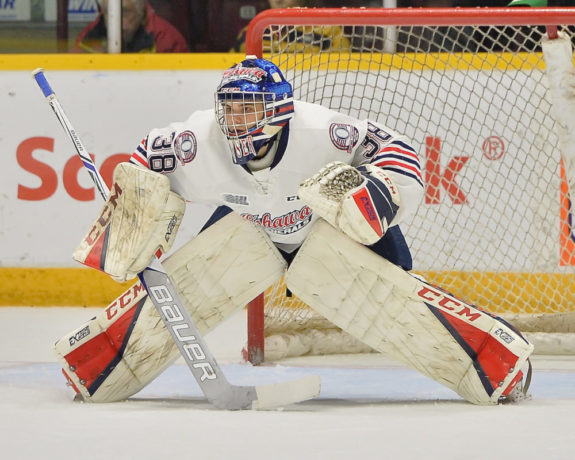
Fortunately, there are two goalies in the system who have flashed the potential to be potential NHL players one day to varying degrees.
The highest-upside goaltender in the system that many will talk about is undoubtedly Keyser. The 20-year-old is currently playing in the AHL due to a leg injury to Daniel Vladar. In four games, he’s allowed 12 goals but has still flashed the potential that many have been excited about since his time in the OHL with the Oshawa Generals.
The other goalie who many seem to forget about more often than not is Swayman. Consistently impressive at the University of Maine and proving he deserves to be in the conversation for the best goaltending-prospect in the system, Swayman has turned things up a notch so far this season.
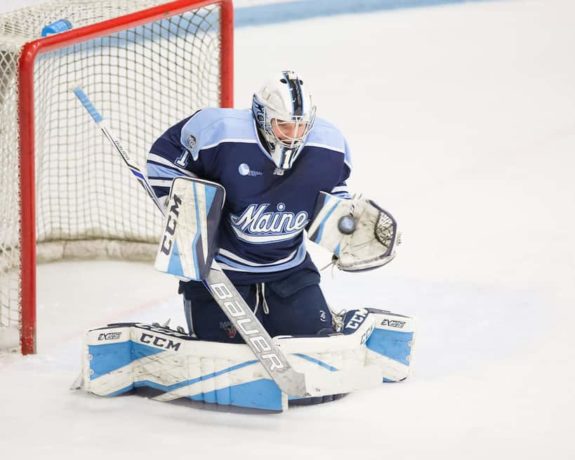
In eight games, Swayman has allowed only 17 goals, posting a .942 save percentage and 2.12 goals-against average.
Tier 4 – NHL Hopefuls Who Have a Shot
The fourth tier of the prospect pyramid is one that’s filled with players who have distinct chances at making an NHL roster one day, be it in a bottom-six capacity, a middle to a bottom-four role on defense or even as a fringe-starting goaltender or career backup.
There’s room to grow for these players but for now, they look like role players who could be blocked by other players ahead of them or who still need to round out their game.
This tier includes the following players:
Daniel Vladar, Ryan Fitzgerald, Oskar Steen, Axel Andersson, Dan Vladar and Pavel Shen
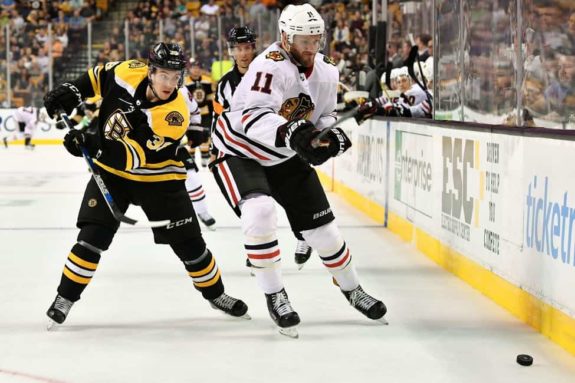
These players all have a distinct chance of making an NHL roster one day, though their upside remains unknown.
For Fitzgerald, his potential has always appeared to be that of an effective bottom-six forward who can add grit and secondary scoring to an NHL club one day.
For Shen, Anderson and Steen, however, the ceilings all appear to be higher with their floors being what keeps them from a higher position for the time being.
For Vladar, an NHL job is still a possibility one day. He projects more to be a long-term backup than a career-starter and his days as the best prospect in the system may be numbered. He’s still the closest player on the roster to making the jump to the next level, though, and it’s too soon to say he’ll never make the league.
Tier 5 – Role Players at Best
For the remainder of the Bruins’ prospects, the ceiling appears to be role players at best (or relative unknowns who will need to work hard to improve their spot within the system).
These players have the ability to one day make an NHL roster one day but as it stands, they don’t project to be impactful players at the next level.
The players in this tier include:
Jack Becker, Cameron Hughes, Wiley Sherman, Emil Johansson, Anton Blidh, Curtis Hall, Joona Koppanen, Dustyn McFaul, Cam Clarke, Victor Berglund, Roman Bychkov, Matias Mantykivi, Jake Schmaltz,
Related: Bruins’ Injuries Raising Serious Lineup Questions
As was the case with tier 4 – the players in this group could still be better than expected and will be working towards proving that in 2019-20.
Connor Clifton is the best example of that, going from this tier prior to the 2018-19 season starting to eventually playing big-time NHL action in the regular season and postseason (including the Stanley Cup Final) and retaining his job this season.

None of these rankings are set in stone and it’s always up to the players to prove that they are more than what any ranking says. This remains true even with a concept like a prospect pyramid.